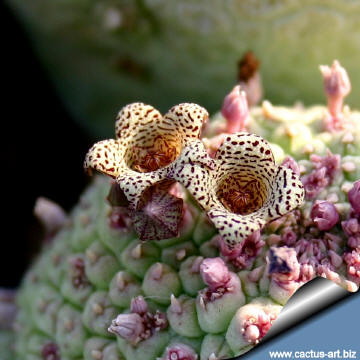|
|
|

Flowers are sessile, fleshy, cream, green or yellow, uniformly coloured
or maculate with reddish or maroon, and glabrous. |
|
Closely related to Larryleachia cactiformis, this species
includes the former Trichocaulon meloformis and
Trichocaulon engleri .
Description: Larryleachia picta is a small
perennial
stem succulent , mostly solitary (or slowly clumping).
Stem: Green or light green or blue-green 5-30 cm high, 20-60 mm
wide, unbranched or sparsely branched, short-cylindric, and tessellate,
with roughly pentangular, flat or depressed tubercles closely set
together;
latex colorless.
Leaves: Persistent, reduced to scales, in spirals or
verticillate,
sessile (and sunken), strongly adscending, 0.05-0.1 cm long.
Roots:
Fibrouse
Flowers: Appear (usually) close to apex of stems in extra-axillary
inflorescences 1 to 3 together on a tubercle apex, each about 6 to 10mm,
in diameter, simple, sessile, fleshy,
abaxially cream, green or yellow, uniformly colored or maculate with
reddish or maroon,
adaxially white, cream, green or yellow, maculate, glabrous.
Blooming season: Flowers open synchronously in
summer.
Fruit: Mericarps, usually paired, acute-angled.
|
 |
 |
|
. |
|
 |
 |
|
. |
 |
 |
|
. |
 |
 |
|
The epidermis is usually of a uniform grey-green colour, but
purple mottled specimens are also known. |
|


Advertising
|
|
|
|
Family:
Asclepiadaceae (Apocynaceae)
(Milkweeds family)
Scientific name: Larryleachia
picta (N.E.Br.) Plowes
Published in: Excelsa, 17: 9 (1996).
Basionym: Trichocaulon pictum N.E.Br.
Origin: Origin: Southern Africa, from central
Botswana into south-western Namibia.
Habitat and biology:
It can be found on the eastern edge of the winter rainfall
region at an altitude of 800 - 1600 m. They are highly succulent
and adapt to very harsh and bright habitats. Larryleachia is a
very fine example of
convergent evolution, very easy to mistake for a cactus. However there
is
very similar development of very similar characteristics in plants evolving
in similar conditions, although separated by very great distances or
otherwise of impossible contact. Indeed, one species in the genus is called
Larryleachia cactiforme.
Common Name: Apple Milkweed
Synonyms:
- Trichocaulon meloforme Marloth
Published in: Trans. Roy. Soc. S. Afr 2. 239., 1912
- Larryleachia meloformis (Marloth) Plowes
- Lavrania picta (N.E.Br.) Bruyns subsp. picta
- Leachia meloformis (Marloth) Plowes 1992 (incorrect
name)
- Leachia picta (N.E.Br.) Plowes
- Leachiella meloformis (Marloth) Plowes
- Leachiella picta (N.E.Br.) Plowes
- Trichocaulon engleri Dinter
- Trichocaulon pictum N.E. Brown 1909
- Trichocaulon simile auct. - sensu Marloth
- Hoodia meloformis (Marl.) Halda 1998.a

|
|
|
|
|
|

This plant has a highly specialized
pollination biology, that depends upon flies which are deceived,
partially trapped and used as collectors of the
pollinia which they transport to a cyathium (Flower) on another
plant.
Note:
The genus Larryleachia was erected by Plowes in honour of Leslie
Leach, an English-born electrical engineer, self-taught botanist, and
specialist in Asclepiads and Euphorbias. This plant is perhaps best
known as one of the smooth-stemmed members of Trichocaulon.
The
spiny-stemmed species was combined with Hoodia, leaving the
former in need of a new generic home. The new genus Leachia was rendered
invalid as it had already been applied to a genus in the Asteraceae.
Realizing his error, Plowes chose a new name Leachiella. Despite
having checked as to the availability of that name no one realized until
after publication that it had been used before for a genus of red algae.
In 1997 it was finally designated as Larryleachia picta along
with several other smooth-stemmed species of the former Trichocaulon
genus, now the preferred designation among botanists today.
Cultivation:
It
is a slow growing species of relatively easy
culture, water
normally in the
growing season,
but do not overwater (very
wet-sensitively, especially in light of its small root system)
Water thoroughly only if soil is dry to
the touch, let soil dry in between to prevent root rot,
keep dry in the winter with ample
airflow.
Potting medium:
Since roots are quite shallow, use a
cactus mix or add extra
perlite or
pumice to regular soil
potting soil. A gritty, very free-draining
compost is suitable, and
clay pots help the plants to dry out between watering.Feed with a high potassium
fertilizer in summer.
Care must be taken with watering as
they tends
to become swollen and untidy in growth habit if given too much
water and shade.
High levels of light are needed to
flower and for good development.
Can be sunburned if moved
from shade/greenhouse into full sun too quickly. During the spring it
may be able to take full sun until the heat arrives at the end of
spring. In an area that has hot afternoon sun, it may be able to take
full morning sun, but requires afternoon shade or afternoon light shade.
If grown correctly, it will reward the grower with generous
displays of flowers.
It is quite frost resistant if
kept dry, hardy as low as -5° C (or less)
Propagation: Seeds or division, wait
until the
offsets that appear at the
base of old clustered
specimens
are 1/3 the size of the parent and then detach and plant.
Photo of conspecific taxa, varieties, forms and
cultivars of plants belonging to the
Larryleachia cactiforme
complex.
(This
Taxon
has lots of synonyms, with several controversial varieties and subspecies):
|
|